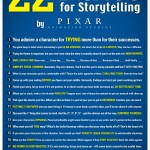Storytelling and Storyfeeling
 Storytelling is an essential part of design. When it comes time to deliver your new idea, you risk it dying in front of your stakeholder’s eyes if you don’t convey it in a compelling way. Think about how many times you have had someone trying to convince you of an idea by telling you, or handing you an excel spreadsheet, a list of graphs, or a bulleted Powerpoint deck. You probably weren’t emotionally very engaged. Perhaps you have tried this yourself and you found the audience not nearly as excited about or connected to the topic as you had hoped.
Storytelling is an essential part of design. When it comes time to deliver your new idea, you risk it dying in front of your stakeholder’s eyes if you don’t convey it in a compelling way. Think about how many times you have had someone trying to convince you of an idea by telling you, or handing you an excel spreadsheet, a list of graphs, or a bulleted Powerpoint deck. You probably weren’t emotionally very engaged. Perhaps you have tried this yourself and you found the audience not nearly as excited about or connected to the topic as you had hoped.
Data and bullet points are valuable, but they can be robotic and inhuman. Consider storytelling… an engaging way of communicating information that has been around since the beginning of time. Pixar, makers of the animated films Toy Story, Monsters Inc, & Finding Nemo to name just a few, are masters of storytelling, and they have captured a set of 22 storytelling rules. While their stories are for entertainment, they are also a way of teaching and conveying creative vision of an alternate world…exactly the role of a designer or anyone who is trying to convince someone else that things could be different from the way they are now.
One of the most prominent rules of Pixar’s storytelling list (#4) is the “Story spine”, a technique developed by playwright and improvisor Kenn Adams. The story spine provides simple prompts for creating a story that establishes a character and context (Once upon a time there was a…), a norm (And every day…), a shift in the norm (until one day…), and the result (and because of that……until finally….). This helps gently move an audience from a familiar place (the status quo) to a new place (your vision of the way things could be). This is the power of stories.
In addition, stories have the added value of connecting your audience to a character (or characters) they can identify with. And, as they begin to see parallels between the character’s life and their own, they can more easily digest the change you are proposing and even get excited about your future vision (especially because the character usually ends up better off!).
Storytelling is a human way to convey information. We all tend to have no trouble telling stories at parties and among our friends, so with the help of the story spine, it stands to reason that using stories to engage an audience in our vision of the future, no matter how big or small, is within reach for all of us.
For the practiced storytellers out there, I offer an additional challenge. Engage people further by shifting from story-telling to story-feeling. It is one thing to tell people about a character who goes on a journey, encounters an obstacle, overcomes that obstacle with some great new tool, and then lives a better life because of it. This is certainly more intriguing than a bulleted list of specifications and data targets. But imagine the impact if you could get your audience to BE the character in your story? What if they could experience encountering the obstacle you described and heroically overcoming it with the new product (process, environment, ap, etc) you designed? Wouldn’t that be a compelling way to promote the new tool or idea you have created?
If someone can internalize and emotionally connect with a new idea, they will do more than agree with it. They will begin to own it. The experience you describe in your story becomes their experience and even greater than identifing with the character, they will become the character. This means they can provide real, honest, constructive feedback and they will have emotional investment, two powerful components that will ensure your ideas move forward.
So, as you work to change the world a little bit at a time, consider this: How might you convey your ideas using storytelling? Who might be the main characters in your stories? How will you tell the story in a compelling way? And most importantly, how might you get your audience to not just hear your story, but to experience your story first hand?
Poster designed by: John J. Kimball